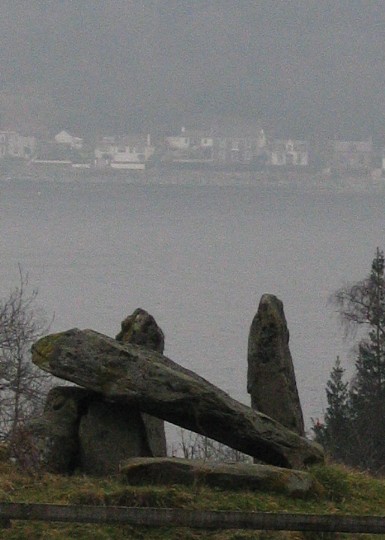

PRAWR 352 – only partly visible under the encroaching vegetation.

PRAWR 285 – Stone 1 (See Miscellaneous)

PRAWR 285 – Stone 1

PRAWR 285 – Stone 1

Number 295 in “Prehistoric Rock art of the West Riding”.

General view from the SW showing chamber, facade and capstone.
The NE-facing cairn was said, in 1794, to be 120 ft long (37m). It is currently only visible for about 20m although there is a stone well to the SW which may mark the original end.

Facade looking SE.
Facade dimensions – 11.7m across x 2.8m deep.

Behind the facade looking NW.
The stone with the cross is on the right.

The cross on the rear of one of the facade stones. 15cm high.

The chamber.
The likely backstone can be seen making it 8.4m long and roughly 1m wide.
It has three compartments.

The NW side of the chamber and the slipped capstone.
The stone on the right is 1.6m high.

From the NW.
Overlooking the Clyde and Greenock.

From the E.

From the N.

All that remains of the SW chamber.
The portal stone in the foreground is 1.1m high.

The NE chamber.
From the NE with the SW chamber in the background.
The chamber is about 5m x 1m.
The cairn would have been about 28m long.

The NE chamber – from the S.

General view from the S.
Chamber in the foreground with slipped capstone.
Portal stones in the background.

From the E.
The shape of the stones to the right means they are more likely to be portal stones than side stones of another compartment to the chamber. They are 2.3m high.
But what is the large stone beyond them?

Between the portal stones looking into the chamber.
The septal stone is at the front of the picture and the cup and ring mark can be seen just above the leaf.
The excavator (Gordon Childe, no less) thought that the septal stone had been shaped to produce the central dip in the upper edge.

Detail of the cup and ring.
The ring is rather closer to the cup and the cup rather larger than is normal on cup and ring art.
Apologies for the absence of scale – the diameter of the cup and ring is about 9cm.

A bird’s eye view of the chamber with the septal stone at the top of the picture and the cup mark just about visible above the moss line.
Dimensions – 1.5m x 1.0m x 1.6m deep. The septal stone is 1.3m high.

Long zoom shot from the SW
Showing the location overlooking the Holy Loch

The front.
The two portal stones are 1.6m and 1.8m above the ground.
The chamber has only one compartment and measures 3.2m x 0.9m.

From E.
The capstone (2.3m x 2.1m) has slipped and on the E side rests only on the mound.

From the W.
Showing the 3.2m slab which formed the NW side wall of the chamber.

A view of the back (from the SW).
The stone in the foreground is probably one of the chamber sidestones removed from its position.

The alignment viewed over the sighting stones on the main sighting platform {C}.
Not taken from the viewing area but taken to show the approximate place on the horizon where the midsummer sunrise takes place. Due to the cloudy conditions, the far distant hills are not fully visible.
Although the apparatus for an accurate sighting appears to be in place, one problem is that the declination here would not indicate the solstice in (say) 1800 bce but around 15 days before or after.




















